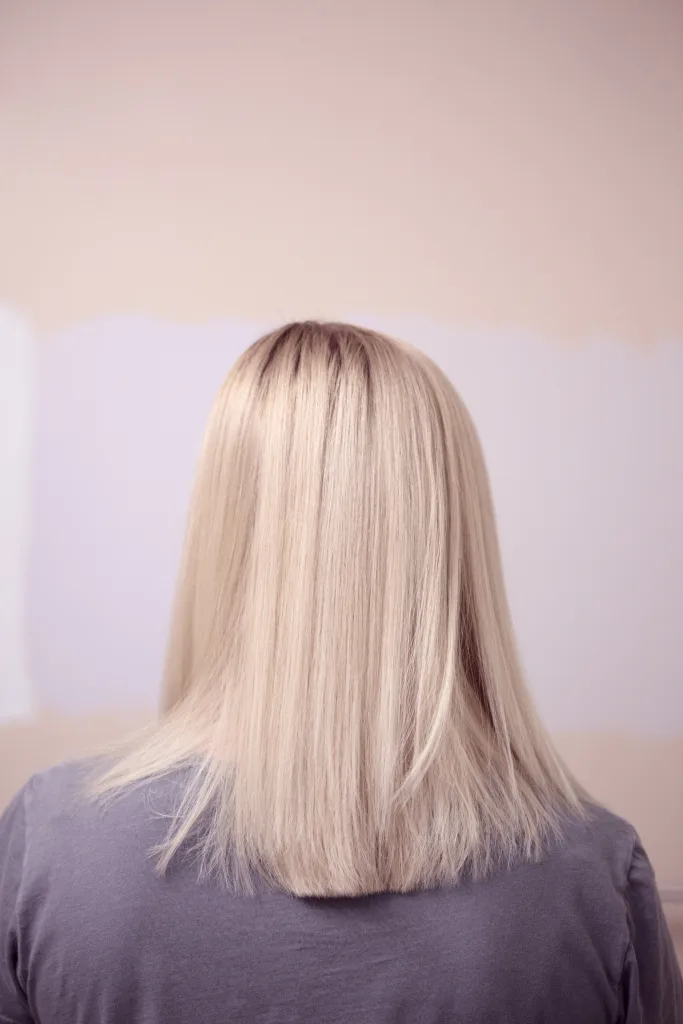Hair growth is a fascinating and complex process that varies from person to person. Many factors can contribute to uneven hair growth, leaving some individuals with longer strands in certain areas while others lag behind. If you find yourself wondering why your hair seems to grow at different rates, read on to discover some possible reasons behind this phenomenon.
Firstly, it’s important to understand that each hair strand goes through its own growth cycle, which typically lasts between two to six years. This means that different hairs on your head are at different stages of this cycle at any given time. As a result, some hairs may be actively growing, while others may be in a resting or shedding phase. This natural cycle cannot be altered or extended by external factors, as it is primarily determined by your DNA.
Another factor that can contribute to uneven hair growth is the circulation of blood to the hair follicles. Each hair follicle has its own blood supply, and it’s possible that one side of your head has better circulation than the other. Improved blood flow means that nutrients and oxygen are delivered more efficiently to the hair follicles, promoting faster hair growth. Conversely, poor circulation can lead to slower growth in certain areas, resulting in an uneven appearance.
Your lifestyle and habits can also influence the rate of hair growth and contribute to unevenness. The food you eat, level of stress, and the amount of moisture your hair receives can all impact its health and growth. A well-balanced diet rich in vitamins and minerals, coupled with a low-stress lifestyle and proper hair care routine, can help promote more consistent and even hair growth.
Lastly, genetics play a significant role in determining the growth rate and pattern of your hair. Just as some individuals may inherit certain physical traits from their parents, such as eye color or height, hair growth patterns can also be influenced by genetics. If you have family members with uneven hair growth, it’s possible that you may experience a similar pattern.
It’s crucial to note that uneven hair growth is a natural occurrence and is not something that can be easily altered. While there are certain treatments and products available that claim to promote faster hair growth, their effectiveness may vary from person to person. It’s always best to consult with a dermatologist or trichologist if you have concerns about your hair growth.
Uneven hair growth is a result of various factors, including the individual growth cycle of each hair strand, blood circulation to the hair follicles, lifestyle choices, and genetic predisposition. While it may be frustrating to have different lengths of hair throughout your head, it’s important to embrace and care for your hair in its natural state. Remember, everyone’s hair is unique, and embracing its individuality can lead to a healthier and happier relationship with your locks.
Why Is My Hair Growing At Different Lengths?
The reason why your hair grows at different lengths is due to the natural growth cycle of each hair strand. This growth cycle, also known as the hair growth cycle, is a continuous process that occurs independently for each hair on your head.
Here is a breakdown of the different stages of the hair growth cycle:
1. Anagen Phase: This is the active growth phase of the hair strand. It typically lasts anywhere from two to six years, depending on your individual genetics. During this phase, the hair follicle is actively producing new cells, resulting in hair growth. The length of this phase determines the maximum length your hair can grow.
2. Catagen Phase: After the anagen phase, the hair strand enters the catagen phase, which is a transitional phase. This phase lasts for a few weeks and marks the end of active hair growth. The hair follicle shrinks and detaches from the blood supply, preparing for the next phase.
3. Telogen Phase: The telogen phase is the resting phase of the hair growth cycle. This phase lasts for a few months, during which the hair strand is no longer growing. Instead, it remains attached to the hair follicle while a new hair begins to form beneath it.
4. Exogen Phase: The exogen phase is the shedding phase of the hair growth cycle. During this phase, the old hair strand is pushed out of the follicle by the new hair strand growing beneath it. On average, we shed about 50 to 100 hairs per day.
After the exogen phase, the hair follicle re-enters the anagen phase, and the cycle starts all over again. Since each hair strand is at a different stage of the growth cycle at any given time, it is normal to have hair strands of varying lengths on your head.
Factors such as age, genetics, overall health, and hair care practices can also influence the length and quality of your hair. However, it’s important to note that the length of your hair growth cycle is determined by your DNA and cannot be extended or altered by external factors.
Your hair grows at different lengths because each hair strand has its own growth cycle. This cycle consists of the anagen, catagen, telogen, and exogen phases, which determine the length and growth of your hair.

Why Does One Side Of My Hair Grow Differently?
There can be various factors that contribute to the uneven growth of hair on different sides of the head. While it is not uncommon for hair to grow at different rates or appear thicker on one side, a few reasons may explain this phenomenon:
1. Blood circulation: Each hair follicle has its own blood supply, and it’s possible that one side of the head has better circulation. Improved blood flow can promote faster hair growth and result in thicker hair.
2. Genetics: Hair growth patterns can be influenced by genetics. It is possible that certain genes may be more active on one side of the head, leading to differences in hair growth.
3. Hair care practices: The way you care for your hair can impact its growth. If you consistently style or manipulate your hair on one side more than the other, it may cause differences in growth. For example, excessive brushing, heat styling, or wearing tight hairstyles on one side could affect the hair’s health and growth rate.
4. Scalp health: The condition of your scalp plays a crucial role in hair growth. If the scalp on one side is healthier than the other, it may provide a more favorable environment for hair growth.
5. Hormonal imbalances: Hormonal fluctuations can affect hair growth patterns. Hormones like estrogen and testosterone can impact the hair follicles’ activity, potentially leading to differences in growth on different sides of the head.
It’s worth noting that these factors are not definitive explanations but rather potential reasons for the observed difference in hair growth. If you have concerns about your hair growth, it’s recommended to consult a dermatologist or trichologist for a thorough evaluation and personalized advice.
Why Did My Hair Grow Uneven?
Uneven hair growth can have several causes, including genetic factors, dietary issues, stress levels, and inadequate hair care practices. Understanding these factors can help you identify the potential reasons for your uneven hair growth.
1. Genetics: Hair growth patterns are largely determined by our genes. Some individuals naturally have hair that grows at different rates or in different directions, resulting in uneven growth. Unfortunately, there isn’t much you can do to change this aspect of your hair growth.
2. Diet: Poor nutrition can impact hair growth. A lack of essential vitamins and minerals, such as iron, zinc, biotin, and vitamin D, can lead to slower and uneven hair growth. To promote healthy hair growth, ensure your diet includes a variety of nutrient-rich foods, such as fruits, vegetables, whole grains, lean proteins, and healthy fats.
3. Stress: High levels of stress can disrupt the natural hair growth cycle. When you’re stressed, your body diverts resources away from non-essential functions like hair growth. This can result in uneven growth or even hair loss. Managing stress through relaxation techniques, exercise, and self-care practices may help promote more even hair growth.
4. Hair care practices: Improper hair care can lead to breakage and damage, resulting in uneven growth. Over-styling, excessive heat styling, harsh chemical treatments, and tight hairstyles (like ponytails or braids) can weaken the hair shaft and cause breakage. Opt for gentle, nourishing hair care routines, including using sulfate-free shampoos, conditioning regularly, and avoiding excessive heat and chemical treatments.
5. Scalp health: A healthy scalp is essential for optimal hair growth. Conditions like dandruff, fungal infections, or excessive oiliness can disrupt the hair growth cycle and lead to uneven growth. Maintain good scalp hygiene by washing regularly with a mild shampoo and addressing any specific scalp issues with appropriate treatments.
It’s important to note that hair growth is a slow process, and it may take time to see noticeable changes. If you’re concerned about your hair growth, consult a dermatologist or trichologist who can evaluate your specific situation and provide personalized advice.
Does Uneven Hair Grow Even?
Uneven hair does not naturally grow even. The growth of hair is not uniform across the scalp. Hair growth occurs at different rates and lengths in different areas of the head. If you were to start with a shaved head, the hairs near the back of your neck would reach your shoulders before the hairs on the top of your head, simply because they are already closer to the shoulders. The hairs on top would need to grow much longer to reach the same length. This uneven growth is a natural occurrence and cannot be balanced out on its own.

Conclusion
Hair growth is a complex process that is influenced by various factors such as genetics, circulation, diet, stress levels, and moisture. Each hair strand has its own growth cycle, which cannot be extended or altered by external factors. Uneven hair growth can occur due to differences in blood supply to the hair follicles, which can vary from one side of the head to the other. Lifestyle factors such as diet and stress can also contribute to uneven growth. It is important to understand that hair growth does not naturally even out, as the length of each hair strand is determined by its position on the scalp. Therefore, if you are experiencing uneven growth in your curly hair, it is advisable to assess your lifestyle and make necessary changes to promote healthy hair growth.
